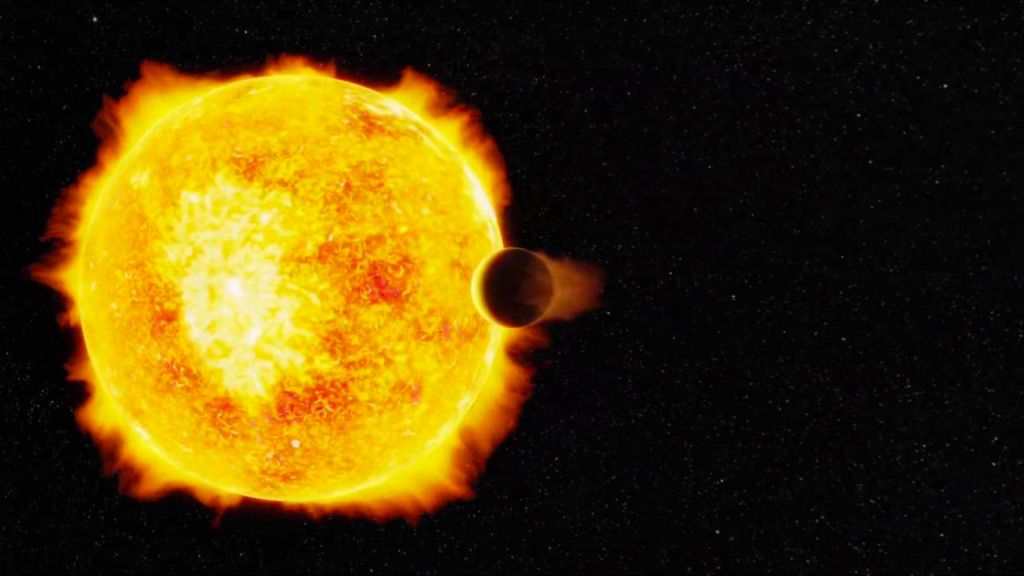Astronomers have discovered the most reflective planet outside the solar system ever seen. The ultra-hot extrasolar planet, or exoplanet, acts like a cosmic mirror because it is covered by reflective clouds of metal.
The planet, designated LTT9779 b, is located around 264 light-years from Earth and reflects around 80% of the light that shines on it from its parent star. As a comparison to LTT9779 b, Earth reflects just 30% of the light that falls on it from the sun. The ultra-hot LTT9779 b is so reflective that it is the first exoplanet found that gives the solar system’s shiniest planet, Venus, a run for its money; Venus has a thick layer of clouds that reflect around 75% of incident sunlight.
The exoplanet is, in turn, almost five times as wide as Earth, meaning it is also the largest cosmic mirror ever discovered. “Imagine a burning world, close to its star, with heavy clouds of metals floating aloft, raining down titanium droplets,” research co-author and Diego Portales University astronomer James Jenkins said in a statement.
Related: Good news for the alien life hunt: Buried oceans may be common on icy exoplanets
While LTT9779 b was first discovered by NASA’s Transiting Exoplanet Survey Satellite (TESS) mission in 2020, the world’s highly reflective nature wasn’t uncovered until a follow-up investigation by the European Space Agency exoplanet-hunting spacecraft, CHaracterising ExOPlanet Satellite (CHEOPS). LTT9779 b is around the size of the solar system ice giant Neptune, which, coupled with its roasting temperature, class it as an ultra-hot Neptune.
How LTT9779 b became a Neptune-sized celestial mirror
Initially, the high reflectivity of LTT9779 b, a quality known as ‘albedo,’ was a mystery to scientists. This is because most planets, other than ice worlds or planets with reflective cloud layers like Venus, have low albedos as a result of their atmospheres or surfaces absorbing starlight, thus preventing it from being reflected back into space.
LTT9779 b was predicted to have a low albedo because, with a surface temperature of around 3,650 degrees Fahrenheit (2,000 degree Celsius) on the side of the exoplanet that permanently faces its star, it should be too hot to form clouds of water. This high temperature should make LTT9779 b too hot even for even clouds of metals or glass to form.
“It’s a planet that shouldn’t exist,” says research co-author and Observatory of Côte d’Azur researcher Vivien Parmentier. “We expect planets like this to have their atmosphere blown away by their star, leaving behind bare rock.”
The existence of such a planet prompted researchers to explore other theories for how these metal clouds formed. “It was really a puzzle until we realized we should think about this cloud formation in the same way as condensation forming in a bathroom after a hot shower,” Parmentier added. “To steam up a bathroom, you can either cool the air until water vapor condenses, or you can keep the hot water running until clouds form because the air is so saturated with vapor that it simply can’t hold anymore.”
The team thinks that LTT9779 b got its metal clouds and its high albedo when its atmosphere was oversaturated with silicate and metal vaporized by scorching hot temperatures on the planet’s permanent dayside.
The reflective nature of LTT9779b isn’t its only extraordinary quality, however. The exoplanet is also an example of a planetary type that has eluded astronomers for decades and remains mysterious.
Ultra-hot Neptune is an example of a missing planet type
As an ultra-hot Neptune which orbits so close to its star, LTT9779b is the first in a population of “missing planets” to be discovered. Planets of this size and mass, which orbit close to their parent stars, have been long-absent from the exoplanet catalog, which now contains over 6,000 worlds.
All other planets found so close to their parent star that they orbit them in under a day have been so-called “hot Jupiter” planets with widths around ten times that of Earth, or rocky worlds smaller than twice the size of our planet.
This left an absence of planets with sizes and mass in between these categories at close proximities to their stars. An absence that has come to be known as the “hot-Neptunian desert” by scientists.
With a size just larger than its ice-giant namesake and a 19-hour orbit, LTT9779 b sits firmly in this gap.

The planet’s survival in the hot-Neptunian desert so close to its star could share an explanation with its high reflectivity characteristic.
“We believe these metal clouds help the planet to survive in the hot Neptune desert,” research lead author and Marseille Astrophysics Laboratory scientist Sergio Hoyer said. “The clouds reflect light and stop the planet from getting too hot and evaporating. Meanwhile, being highly metallic makes the planet and its atmosphere heavy and harder to blow away.”
LTT9779 b is likely to be the focus of extensive study over the coming years, with the exoplanet representing a fine observational target for both the James Webb Space Telescope and the Hubble Space Telescope. This should allow scientists to better understand its atmosphere, clouds, and its other characteristics.
The team’s research is published in the journal Astronomy & Astrophysics.
